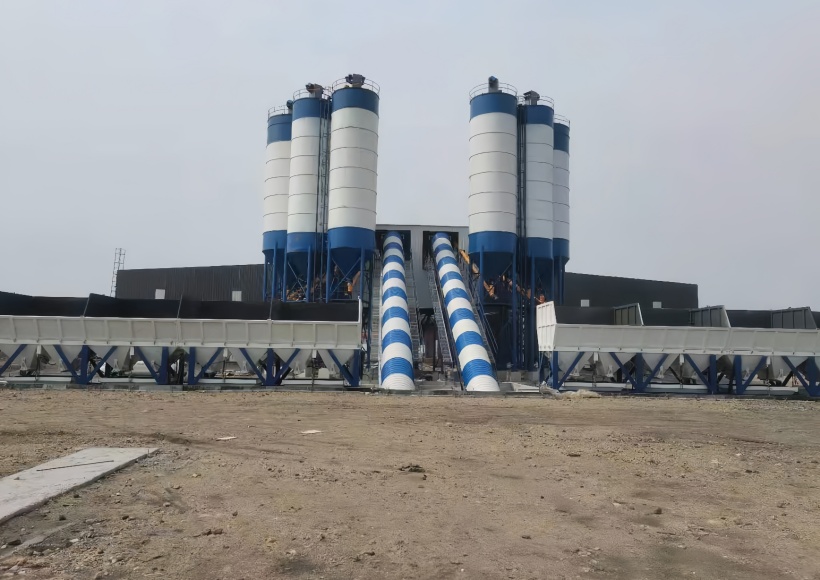What is self-compacting concrete?
Self-compacting concrete (SCC), as a high-performance building material, plays an increasingly important role in modern engineering construction. Its unique performance characteristics and special requirements for production equipment necessitate corresponding technical upgrades and equipment modifications for concrete mixing plants. This article will delve into the characteristics of self-compacting concrete and the specific requirements it places on mixing plant equipment.
Properties and Advantages of Self-Compacting Concrete
Self-compacting concrete is an advanced building material that can flow and compact under its own gravity, fully filling formwork spaces. Compared to ordinary concrete, self-compacting concrete possesses three notable properties: **high flowability**, **interstitial flowability**, and **anti-segregation**. These characteristics make it particularly suitable for construction sites with dense reinforcement, complex structures, or difficult-to-vibrate locations.
From a technical perspective, the mix design of self-compacting concrete offers distinct advantages. The cementitious material dosage is typically maintained at 400-600 kg/m³, the water dosage is controlled at 150-180 kg/m³, the water-to-binder ratio does not exceed 0.45, and the sand content is maintained at around 50%. This mix ensures that the concrete maintains high fluidity while also exhibiting good stability and durability.

What are the technical requirements for concrete batching plant equipment?
Precise metering system
The production of self-compacting concrete places extremely high demands on metering accuracy. Aggregate metering accuracy must be controlled within ±2%, powder metering accuracy should reach ±1%, and water and admixture metering accuracy must be better than ±1%. To achieve this, the concrete batching plant needs to be equipped with high-precision sensors and sophisticated control software, and utilizes separate metering methods to avoid cumulative errors.
Efficient mixing system
Forced mixers are essential equipment for the production of self-compacting concrete. Compared to conventional concrete, self-compacting concrete requires a longer mixing time, typically 30-60 seconds longer. A countercurrent vertical-shaft planetary bidirectional mixer is recommended. Its unique mixing trajectory ensures thorough mixing and ideal uniformity.
The mixing system should have sufficient power reserve to cope with the high cementitious material content and paste viscosity of self-compacting concrete. A high-quality mixing system can achieve a highly uniform concrete mix within the specified time, ensuring the full effectiveness of the high-performance water-reducing agent.
A Comprehensive Material Storage System
The design of the material storage system directly impacts production continuity and quality stability. Powder storage silos should be equipped with effective arch-breaking devices and appropriate ventilation to ensure smooth material discharge.
The aggregate system should ensure an adequate supply of materials. All storage equipment should incorporate necessary environmental protection measures, including pulse dust collectors and automatic dust cleaning systems, to meet the environmental requirements of modern production.
What are the key control points in the self-compacting concrete production process?
Mix Ratio Management
The mix ratio design of self-compacting concrete must ensure that the three key indicators of filling, interstitial flow, and segregation resistance are met simultaneously. The paste volume per unit volume should be controlled between 0.32 and 0.40, as this parameter has a decisive impact on the ultimate performance of the concrete. The production process must strictly adhere to the established mix ratio; any slight deviation can affect concrete quality.
Process Parameter Control
Mixing time is a key process parameter that requires careful control. Research has shown that a mixing time of 2 minutes produces optimal results.
Quality Monitoring System
Establishing a comprehensive quality monitoring system is crucial. Each batch of concrete should be tested for slump flow and T50 expansion time to ensure that its performance meets design requirements. Furthermore, the mix should be closely monitored to ensure that aggregate accumulation or segregation, such as edge bleeding, is not present.
Intelligent Control System Configuration
Modern self-compacting concrete batching plants should be equipped with advanced intelligent control systems offering fully automatic, semi-automatic, and manual operation modes, providing greater flexibility and control over production. The control system should be equipped with an industrial computer for user-friendly operation, and convenient and efficient report classification, summary, query, and export functions.
An excellent control system should also include automatic error compensation, automatically adjusting the batch parameters for the next batch based on metering errors from the previous batch. Furthermore, a comprehensive production data recording system enables quality traceability and provides data support for continuous improvement.
Environmental Protection and Maintenance Design
Environmental protection is a crucial consideration for modern concrete mixing plants. Efficient dust removal and automatic dust cleaning systems should be installed within the mixing plant to effectively control dust pollution. Multiple access doors should be located on the sides of the equipment to ensure ample internal access and facilitate daily maintenance and upkeep.
Conclusion
Producing self-compacting concrete is a comprehensive test of a concrete mixing plant's technical capabilities. Equipped with precise metering systems, efficient mixing units, comprehensive material storage systems, and advanced control systems, a concrete mixing plant can consistently produce high-quality self-compacting concrete. This not only enhances the company's technical level and market competitiveness, but also provides high-quality materials for modern construction projects.
As the construction industry continues to demand higher quality and efficiency, the application prospects of self-compacting concrete will continue to expand. Concrete mixing plant companies should actively upgrade their technology and equipment to seize market opportunities and achieve sustainable development.